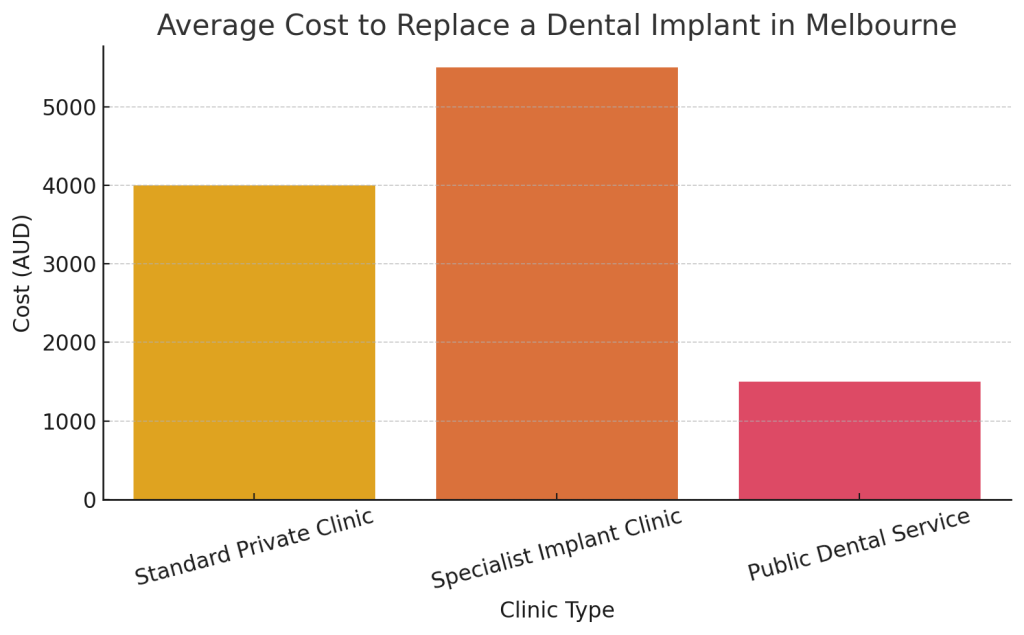Healthcare
How Much Does It Cost to Replace a Dental Implant in Melbourne Without Losing Your Smile or Wallet?

Dental implants are a top-tier solution for restoring your smile — but what happens when you need to replace one? Whether it’s wear and tear, implant failure, or a dodgy crown, replacements can be a dent in both your dental health and your finances.
If you’re in Melbourne and wondering about the cost to replace a dental implant, you’re not alone. This guide breaks it all down — from pricing to options, and how to save a few bucks along the way (without selling your ute!).
The Average Cost to Replace a Dental Implant in Melbourne
The cost of replacing a dental implant in Melbourne varies widely depending on the type of clinic and the complexity of your case.
Here’s a quick comparison of the average prices across different dental care providers:
| Clinic Type | Average Cost (AUD) |
| Standard Private Clinic | $4,000 |
| Specialist Implant Clinic | $5,500 |
| Public Dental Service | $1,500 |
Note: Prices are general estimates. Clinics like Smile Solutions, Dental Boutique, and Melbourne Dental Implant Centre offer varying packages that could be higher or lower depending on your case.
What’s Included in the Cost?
When replacing a dental implant, you’re not just paying for a shiny new tooth. The total cost typically includes:
- Consultation & Imaging – $100–$300
- Surgical Removal (if needed) – $300–$800
- Implant Fixture Replacement – $2,000–$3,500
- Abutment & Crown – $1,500–$2,000
- Additional Procedures (e.g., bone grafting, sinus lift) – $500–$2,000+
So if you’ve been quoted $6,000, it’s not just the titanium post you’re paying for — it’s the full kit and caboodle.

Factors That Affect the Cost
The price can go up (or down) depending on several factors:
- Single vs Multiple Implants: A single replacement is cheaper than doing a few at once, but multiple replacements may come with package discounts.
- Bone Grafting: If your jawbone needs reinforcement, that’s an added cost.
- Crown Material: Zirconia costs more than porcelain-fused-to-metal.
- Complexity of Surgery: A straight swap is cheaper than removing a failed implant and treating infection.
- Location: Clinics in the CBD often charge more than suburban practices.
Public vs Private: What Are Your Options?
Private Clinics
- Pros: Shorter waiting times, advanced tech, more personalised care.
- Cons: Pricey! Expect $4,000–$6,500 per implant replacement.
- Examples: Dental House Group, Pacific Smiles Dental, Bupa Dental Melbourne.
Public Dental Services
If you hold a concession card, you may qualify for treatment at The Royal Dental Hospital of Melbourne or community health services like Merri Health Dental. But be prepared for long waitlists, and not all offer implant replacements.
- Cost: Around $1,000–$1,500 if eligible.
- Downside: Strict eligibility and limited availability.
Health Fund Rebates: Can You Claim?
Yes, but don’t expect a miracle payout.
- Extras Cover: Most private health funds cover part of the crown or surgery but rarely the full implant.
- Annual Limits: Be mindful of annual claim caps — typically around $800–$2,000.
- Tip: Use your limit at the end of the year and top it up the next year for staged treatment.
Funds like HCF, nib, and Medibank offer dental packages, but you’ll need to read the fine print. Some offer “no gap” dental at preferred providers — but implants are usually excluded.
Budgeting & Financing Options
You don’t need to remortgage the house to get your implant sorted. Here are a few smart moves:
- Payment Plans: Most dental clinics now offer interest-free plans via Afterpay, Zip, or MediPay.
- Super Release: Early access to superannuation is an option under compassionate grounds (check with your GP and financial advisor).
- Staged Treatment: Spread the treatment across 6–12 months to split the cost.
- Dental Schools: Check clinics at Melbourne Dental School or RMIT, where supervised students offer discounted procedures.
Real Talk: Is Replacement Always Necessary?
Not always. If it’s just a loose crown or cracked abutment, your dentist might be able to fix it without a full replacement. But if the implant screw is damaged or the jawbone is compromised — it’s time for a replacement.
Final Word
Getting your implant replaced doesn’t mean you need to flog your tools or sell the Hilux. With the right clinic, smart planning, and a bit of help from your health fund or super, you can protect your chompers and your bank balance.
Melbourne has some top-notch dental talent — from high-end specialists in South Yarra and Toorak to community heroes in Preston and Footscray.
So go on, flash that smile proudly. Your new implant’s just a few steps away — and no, you won’t need to sell your surfboard either.

Healthcare
Essential Tips for Boosting Your Digestive Health Naturally

Maintaining good digestive health is one of the most important foundations for overall wellbeing. When your gut is functioning well, you’ll notice better energy levels, improved immunity, balanced mood, and smoother day-to-day comfort. But when digestion becomes sluggish or irritated, it can quickly affect your lifestyle, productivity, and confidence — especially with the busy pace of everyday Australian life.
Thankfully, improving your digestive system doesn’t need to be complicated. By making simple, consistent changes to your diet, hydration habits, movement routine, and stress levels, you can support your gut naturally and sustainably.
Below are essential, science-backed tips to help you boost your digestive health the natural way.
1. Eat More Fibre-Rich Whole Foods
Fibre plays a major role in healthy digestion. It keeps your bowels regular, supports good gut bacteria, and helps prevent constipation.
Great Australian sources of fibre include:
- Wholegrain cereals (Weet-Bix, oats, wholemeal bread)
- Fruits like apples, pears, berries, bananas, mangoes
- Veggies such as carrots, broccoli, spinach, pumpkin, beetroot
- Legumes (chickpeas, lentils, kidney beans)
- Nuts and seeds (chia, flaxseed, almonds)
Aim for a variety of colourful, whole foods each day. Diversity is key to creating a strong and stable digestive health environment.
2. Stay Hydrated Throughout the Day
Water keeps things moving in your digestive tract. Without enough hydration, stool becomes harder and more difficult to pass, which can lead to bloating and discomfort.
Helpful hydration habits:
- Drink 6–8 glasses of water daily (more in hot Australian summers)
- Sip water consistently, rather than drinking large amounts at once
- Include herbal teas like peppermint, ginger, or chamomile for added digestive support
- Increase fluids when eating high-fibre foods
Hydration is one of the simplest yet most overlooked strategies for improving digestive health.
3. Add Fermented Foods for Gut-Friendly Probiotics
Fermented foods naturally contain beneficial bacteria that support a healthy gut microbiome. These probiotic-rich foods can help balance digestion, enhance nutrient absorption, and reduce gas or bloating.
Probiotic-rich options to include:
- Yoghurt with live cultures
- Kefir
- Kombucha
- Sauerkraut
- Kimchi
- Miso
Try incorporating a small serve into your daily meals to gradually improve your digestive health.
4. Limit Highly Processed Foods
Ultra-processed foods often contain excessive sugar, additives, low-quality fats, and limited fibre — all of which can disrupt gut function and irritate digestion.
Try cutting down on:
- Fast food
- Packaged snacks
- Soft drinks
- Deep-fried items
- Foods high in artificial sweeteners
Instead, choose whole, fresh, home-cooked meals whenever possible. Your digestive health will thank you for it.
5. Manage Stress Levels to Support Gut Function
The gut and brain are closely connected. Stress can directly affect your digestive system, causing symptoms like cramps, diarrhoea, constipation, and indigestion.
Ways to reduce stress naturally:
- Gentle exercise or daily walks
- Deep breathing techniques
- Mindfulness and meditation
- Taking breaks during a busy workday
- Getting enough sleep
- Spending time outdoors or at the beach
Improving mental wellbeing is a powerful tool for strengthening digestive health.
6. Move Your Body Regularly
Physical activity supports healthy bowel movements, increases digestive motility, and helps “wake up” a sluggish gut.
Beneficial forms of movement:
- Brisk walking
- Yoga or stretching
- Swimming
- Cycling
- Pilates
- Strength training
Even 20–30 minutes per day can make a noticeable difference to your digestive health and overall comfort.
7. Chew Food Slowly and Mindfully
Digestion starts in the mouth. Many Australians rush meals during work breaks or busy days, which can lead to swallowing air, bloating, and incomplete digestion.
Try:
- Eating smaller bites
- Chewing thoroughly
- Avoiding screens while eating
- Taking time to enjoy meals
Slowing down gives your digestive system a smoother, easier job.
8. Avoid Overeating and Late-Night Meals
Large meals can overwhelm your digestive tract. Eating too late in the evening may also cause discomfort or acid reflux.
Tips:
- Prioritise earlier dinners
- Opt for smaller, balanced meals
- Listen to hunger cues
- Avoid lying down straight after eating
These small adjustments support your digestive health and help you feel lighter and more energised.
9. Consider Prebiotics and Probiotics
In addition to fermented foods, supplements may help if you’re experiencing ongoing digestive issues.
Prebiotics feed your good gut bacteria.
Found in foods like:
- Garlic
- Onions
- Bananas
- Oats
Probiotics introduce beneficial bacteria.
A good supplement can help restore balance in your gut microbiome.
Always speak to a GP or qualified health professional before starting new supplements, especially if you have a digestive disorder.
10. Get Regular Health Check-Ups
If you’re experiencing persistent bloating, pain, diarrhoea, or constipation, it’s important to consult your GP. Conditions like coeliac disease, IBS, lactose intolerance, and food allergies are common and manageable with proper support.
Regular check-ups ensure your digestive health stays on track and any underlying issues are addressed early.
Final Thoughts
Improving your digestive health naturally doesn’t require drastic changes — just simple, mindful habits you can weave into your daily routine. By choosing wholesome foods, managing stress, staying hydrated, moving regularly, and listening to your body, you can create a healthier, happier gut for the long term.
A strong digestive system leads to better energy, clearer thinking, stronger immunity, and a more balanced lifestyle — all essential for thriving in the modern Australian environment.
Also Read This: Not Sure Where to Start with SIL Providers in Melbourne? Here’s How the Right Provider Makes a Difference
Healthcare
Not Sure Where to Start with SIL Providers in Melbourne? Here’s How the Right Provider Makes a Difference

So, you’re looking for a SIL provider in Melbourne, but the options feel endless—and a bit confusing, yeah? You’re not alone. Melbourne’s disability support scene is booming, and finding the right provider can genuinely change the game for someone needing a little (or a lot) of support to live independently.
Let’s cut through the jargon and get to the good stuff: what SIL really means, why it’s vital in Melbourne, and how to pick the provider that actually gets it.
What is Supported Independent Living (SIL)?
Think of SIL as a bit of a helping hand—but it’s not just someone popping in now and then.
- It’s ongoing daily support in a shared or individual living arrangement.
- Help with things like personal care, cleaning, budgeting, and meal prep.
- Support plans are customised to align with each individual’s specific daily living requirements.
This is all about independence with dignity. It’s not babysitting; it’s empowerment.
Melbourne’s Disability Support Scene: Why It’s Growing Fast
Here in Melbourne, we’re seeing a real push for more inclusive, community-based living.
- Victoria has over 1.1 million residents with a disability, per ABS stats.
- The NDIS is now active for more than 58,000 Victorians, many seeking SIL options.
- Housing and support services are stretched thin, so choosing right is key.
From the leafy suburbs of Camberwell to bustling Footscray, people are looking for support that fits their life—not the other way around.
How to Spot a Great SIL Provider in Melbourne
So, what makes a SIL provider stand out? Here’s your checklist:
- Tailored support plans – Not cookie-cutter services.
- Qualified staff with empathy – Certification matters, but so does compassion.
- Modern, accessible housing – Wide doorways, ramps, smart tech—no excuses.
- Genuine focus on independence – Not just keeping you safe, but helping you thrive.
Oh, and bonus points if they know where the nearest footy ground or best fish ‘n chips are.
Red Flags: When to Walk Away
Let’s keep it real. Not every SIL provider in Melbourne deserves a gold star. Watch out for:
- Staff that change more often than Melbourne’s weather.
- Vague support plans that sound more like suggestions.
- Facilities that feel more like a hospital than a home.
- No transparency around fees or NDIS funding.
If it doesn’t feel right—trust your gut. You (or your loved one) deserve better.
In Melbourne, we do community well—your SIL provider should reflect that vibe.
The Role of Family and Community
SIL isn’t a solo act. It works best when the whole squad’s involved.
- Families can give insight into past experiences, preferences, and future goals.
- Great providers keep family involved—not shut out.
- Community ties matter too—whether it’s the local Men’s Shed or art classes down the road.
In Melbourne, we do community well—your SIL provider should reflect that vibe.
True Impact: Why the Right Provider Matters
Here’s what you really want to know—does a good provider make a difference? Absolutely.
- Participants with solid SIL support often build skills faster.
- They report higher satisfaction and feel safer in their living environment.
- And importantly, families feel confident that their loved one is in safe hands.
This isn’t just about ticking NDIS boxes. It’s about building a life.
Melbourne Suburbs Leading the Way in SIL
Some areas are doing a stellar job offering quality SIL services. According to NDIS and local provider data:
| Suburb | SIL Options | Accessibility Score (Out of 10) | Public Transport Nearby |
| Preston | High | 9 | Yes |
| Werribee | Moderate | 7 | Yes |
| Ringwood | High | 8 | Yes |
| Dandenong | Moderate | 6 | Yes |
| Brunswick | Low | 5 | Yes |
(Data compiled from various NDIS provider listings and urban infrastructure reports)
Pick a location that fits your way of life and offers services that support your personal development goals.
Final Thoughts: Picking the Right SIL Provider in Melbourne
Choosing the right SIL provider in Melbourne isn’t a quick job—it’s a decision that shapes how you or your loved one will live, grow, and feel daily.
- Ask the hard questions.
- Visit the properties.
- Talk to current clients if you can.
You’re not just picking a service—you’re picking a future.
Need Help Finding the Right Fit?
Don’t go it alone. There are some excellent resources to start your journey:
- NDIS Provider Finder – ndis.gov.au
- Disability Advocacy Victoria – daru.org.au
- Local Area Coordinators (LACs) – These legends can guide you through the process.
FAQs: SIL Providers in Melbourne
1. What is a SIL provider in Melbourne and what do they offer?
A SIL provider in Melbourne offers Supported Independent Living services to NDIS participants, helping them live independently in a shared or individual setting. These services often include personal care, household tasks, and skill-building programs tailored to the participant’s needs in and around Melbourne.
2. How do I choose the best SIL provider near me in Melbourne?
To find the best SIL provider near you in Melbourne, look for registered NDIS providers with strong reviews, accessible housing, culturally inclusive staff, and a proven track record. Focus on providers in your suburb or nearby areas like Preston, Werribee, or Brunswick for convenience and local support.
3. Are there NDIS-approved SIL housing options in Melbourne suburbs?
Yes, many NDIS-approved SIL housing options in Melbourne are available across suburbs like Ringwood, Dandenong, and the Northern Suburbs. These homes are designed for accessibility and support, with 24/7 trained staff and tailored services depending on the individual’s support plan.
4. What’s the average cost of SIL in Melbourne under the NDIS?
SIL expenses in Melbourne differ based on the type of housing setup and the amount of assistance required.
5. Can I visit SIL homes before choosing a provider in Melbourne?
Healthcare
What is Physiotherapy? A Complete Guide to Understanding Its Role in Health

Introduction: What’s the Deal with Physiotherapy?
Physiotherapy. We’ve all heard of it, but how many of us actually know what it is or how it can benefit us? You might think of physiotherapy as just for sports injuries or a quick fix for a bad back, but the reality is much more expansive.
In Australia, physiotherapy plays a crucial role in maintaining and improving physical health. It’s not just about fixing what’s broken; it’s about enhancing your overall quality of life and preventing future issues. But, despite its wide-ranging benefits, physiotherapy is often misunderstood or overlooked. So, let’s break it down and see why physiotherapy should be a key part of your health and wellness routine.
1. What is Physiotherapy?
Physiotherapy is a healthcare profession that focuses on diagnosing, treating, and preventing physical injuries or conditions affecting movement. It uses physical techniques like exercise, manual therapy, and education to improve mobility, manage pain, and restore function.
- Not Just for Sports Injuries: While physiotherapists are often associated with sports injuries, they actually work with a wide range of conditions, from post-surgery recovery to chronic pain management.
- It’s About Prevention Too: Physiotherapists don’t just treat injuries—they help prevent them. They assess your posture, movement patterns, and physical activities to stop problems before they start.
Fun Fact: Physiotherapists are some of the most trusted healthcare professionals in Australia, with more than 30,000 working across the country (Australian Physiotherapy Association).
2. The Key Roles of a Physiotherapist
So, what do physiotherapists actually do? They’re much more than people who fix your dodgy back. Here are some of the main roles they play in your health:
- Rehabilitation Experts: After an injury or surgery, physiotherapists guide you through a tailored rehabilitation plan to restore movement and strength.
- Pain Management: They help you manage chronic pain conditions like arthritis, sciatica, or fibromyalgia with targeted treatments.
- Prevention Specialists: Physiotherapists educate patients on how to avoid injuries by improving posture, mobility, and strength.
- Movement Experts: They assess how you move to identify dysfunction and develop personalised plans to improve your physical performance, whether in sports or daily life.
3. Types of Physiotherapy
Physiotherapy isn’t a one-size-fits-all solution. It’s a broad field, and there are various types that target different aspects of your health. Here are some of the most common types of physiotherapy:
- Orthopaedic Physiotherapy: Focuses on musculoskeletal problems such as joint pain, fractures, and post-surgery rehabilitation.
- Neurological Physiotherapy: Helps patients with neurological conditions like stroke, Parkinson’s disease, or multiple sclerosis.
- Cardiopulmonary Physiotherapy: Involves rehabilitation for people with heart or lung conditions. For example, after a heart attack, physiotherapists help patients regain strength and improve their cardiovascular health.
- Paediatric Physiotherapy: Focuses on children with developmental delays, postural issues, or physical disabilities.
- Geriatric Physiotherapy: Helps elderly patients maintain mobility, prevent falls, and improve balance as they age.
4. Techniques and Treatments Used in Physiotherapy
Physiotherapists have a range of techniques and treatments up their sleeves to help you recover and improve your health. Here’s a rundown of some of the most common:
- Manual Therapy: Hands-on techniques that involve manipulating muscles, joints, and tissues to reduce pain and increase mobility.
- Exercise Therapy: Tailored exercises to strengthen muscles, improve flexibility, and restore movement.
- Heat and Cold Therapy: Cold packs reduce inflammation and swelling, while heat helps relax muscles and increase blood flow.
- Electrotherapy: Involves the use of electrical currents to stimulate muscles, reduce pain, and promote healing.
- Education and Advice: Physiotherapists give you the knowledge and tools to manage your own health, from improving posture to understanding how to avoid injury.
5. The Benefits of Physiotherapy
Physiotherapy isn’t just about treating injury or pain—it’s about improving your overall quality of life. Here are some of the key benefits of physiotherapy:
- Pain Relief: Physiotherapy can provide relief from chronic pain without relying on medication.
- Improved Mobility: If you’re struggling with stiff joints or restricted movement, physiotherapy can help you regain function and mobility.
- Injury Prevention: By improving your strength, posture, and flexibility, physiotherapy helps prevent injuries before they happen.
- Better Posture and Balance: Whether you’re hunching over a desk all day or struggling with balance issues, physiotherapy can correct your posture and improve your stability.
- Long-Term Health: Physiotherapy helps you maintain an active and healthy lifestyle, reducing the risk of future injuries and improving overall fitness.
6. When Should You Consider Physiotherapy?
You might be wondering, “When should I see a physiotherapist?” Well, the answer is simple—if you’re dealing with any of these issues, it’s time to make an appointment:
- Persistent Pain: Whether it’s back pain, neck pain, or joint pain, if it’s been ongoing for a while and nothing seems to work, physiotherapy could provide the relief you need.
- Post-Surgery Recovery: If you’ve had surgery—whether for a joint replacement, fracture, or something else—physiotherapy can help you recover faster and restore full movement.
- Sports Injuries: Whether you’re a professional athlete or just love a weekend run, physiotherapy is essential for treating sports-related injuries like sprains, strains, or tendonitis.
- Difficulty Moving or Walking: If you’re finding it hard to move or walk due to stiffness, weakness, or balance issues, a physiotherapist can help you get back on track.
- Chronic Conditions: If you suffer from conditions like arthritis, fibromyalgia, or sciatica, physiotherapy can provide long-term relief and help manage symptoms.
7. What to Expect During a Physiotherapy Session
If you’re new to physiotherapy, you might be wondering what actually happens during a session. Here’s what you can expect:
- Initial Assessment: The physiotherapist will start by assessing your medical history and any symptoms you’re experiencing. They’ll ask questions about your lifestyle, activity levels, and how your condition is affecting your daily life.
- Physical Examination: They’ll assess your posture, movement patterns, and range of motion to identify any areas of concern. This may include tests like checking how far you can bend or twist.
- Treatment Plan: Based on your assessment, the physiotherapist will develop a personalised treatment plan tailored to your needs. This may include exercises, manual therapy, and other treatments.
- Ongoing Sessions: Physiotherapy often involves multiple sessions, depending on your condition. During each visit, the physiotherapist will track your progress and adjust your treatment plan if necessary.
- Education: Physiotherapists will also educate you on how to manage your condition at home, including exercises to do between sessions and tips on maintaining proper posture.
Conclusion: Physiotherapy – More Than Just a Fix for Injuries
Physiotherapy isn’t just about fixing injuries or managing pain—it’s about improving your overall health and helping you live a better, more active life. Whether you’re recovering from surgery, managing a chronic condition, or just want to prevent injuries, physiotherapy can offer a wide range of benefits.
So, next time you’re feeling a bit stiff, sore, or limited in your movement, consider booking an appointment with a physiotherapist. It’s not just for athletes or the elderly; physiotherapy is for anyone looking to take better care of their body and improve their quality of life.
FAQs
- What types of conditions can physiotherapy treat?
Physiotherapy can treat a wide range of conditions, including musculoskeletal issues, neurological conditions, respiratory problems, and post-surgery recovery. - How many sessions will I need?
The number of sessions depends on the nature of your condition and your personal progress. Your physiotherapist will develop a treatment plan tailored to your needs. - Is physiotherapy painful?
Physiotherapy should not be painful. Some techniques may cause mild discomfort, but your physiotherapist will work with you to ensure you’re comfortable during the treatment. - Can physiotherapy help with chronic pain?
Yes! Physiotherapy is particularly effective in managing chronic pain conditions like arthritis, fibromyalgia, and lower back pain. - Do I need a referral to see a physiotherapist?
In Australia, you can see a physiotherapist without a referral, although some private health funds may require a doctor’s referral for certain treatments.
-

 Healthcare6 months ago
Healthcare6 months agoNot Sure Where to Start with SIL Providers in Melbourne? Here’s How the Right Provider Makes a Difference
-

 Healthcare6 months ago
Healthcare6 months agoWhat Happens After You Start SIL? A Closer Look at the Journey
-

 Healthcare6 months ago
Healthcare6 months agoRegular Community Participation That Builds Belonging—and a Life You Control
-

 Healthcare6 months ago
Healthcare6 months agoWhat is Physiotherapy? A Complete Guide to Understanding Its Role in Health
-

 General6 months ago
General6 months ago7 Guttering Upgrades That Instantly Make Your Home More Attractive to Buyers
-

 General6 months ago
General6 months agoMindful Tech: How Wearables and Wellness Apps Are Transforming Mental Health
-

 Eco Friendly6 months ago
Eco Friendly6 months agoSmarter Cooking, Less Waste: Your Guide to a Zero-Waste Kitchen
-

 Healthcare6 months ago
Healthcare6 months ago5 Signs You Need to See a Psychologist – And Why It’s Totally Okay!



